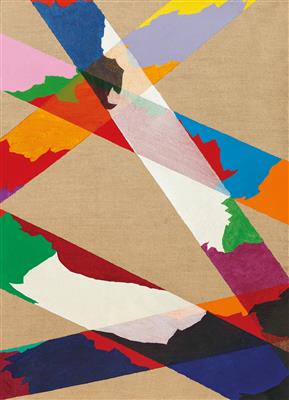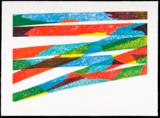Piero Dorazio *

(Rom 1927–2005 Perugia)
Enfeu III, 1969, signed, titled and dated on the reverse, oil on canvas, 90 x 65,5 cm, framed
This work is registered in the Archivio Piero Dorazio, Milan under no. 1969-004950-E788 and it is accompanied by a photo-certificate of authenticity.
Provenance:
R. Romero Collection, Rome (acquired directly from the
artist in the first half of the 1970’s)
thence by descent to the present owner
Renzo Romero who was also an art dealer, former director af the Bussola Gallery in Turin and later of the Pogliani Gallery in Rome, opened with his wife Flavia an etching studio and art gallery first in Via Liguria and then in Via Brunetti in Rome. As Piero Dorazio wrote, the secret of Romero’s success laid in the fact that he was willing to undertake alongside of us that very experience that we intended to practice, one by one, and to share our expectations, attempts and intuitions, as if the artist were the right hand and he, the left. But with the difference that Renzo was always willing not only to undertake any possible experiment, but also to immediately suggest a variant or even a different solution altogether, with constancy and patience that artists with a capital A would never have dreamed of possessing had he not managed, with his typical grace, to persuade each of us of the wisdom of persevering along one tack or of trying another (Piero Dorazio 1978)
According to many artists Romero had the ability to “read” prints better than anyone, and had at the same time the modesty of making everything seem simple and possible within the realm of technique, while many of his colleagues pretended to be custodians of some sacred secrets. His artisits motto was that acid scored the trench but it was Renzo who filled it and he did that with an eye for the format and dimension of the plate, plus a precious ability to choose the format and pressure of the printing press, a special eye for detail and the capacity of reading on a small scale. The art of etching lays behind the final result of a process that is not fully controlled by work of an artist, and the mistery behind this final result could be pleasantly surprising only if the “magician” behind it had extremely good skills. According to Piero Dorazio Romero was also fixated on certain criteria for the formation of opinions about the “quality” of prints and not only of his own.
His opinion is rigorously professional. He refuses prints which are not “originals” – how often have we heard him railing against the commercialization of non-original prints which were flooding the market in 1968-73. An “original” print is one executed by the hand of the artist and approved by him after having pulled a number of proofs with the printer, which has to be precisely numbered in small editions and the plate then “struck.” (Dorazio 1978)
For many long years the Romero Studio has been the point of reference for Roman artists, critics, poets and politicians with a passion for engravings
Renzo’s fame soon extended throughout Italy and beyond, to Europe and America. His prints won several prizes and often someone arrives at his studio unexpectedly, from far away, to see how he manages to make such prints
The progress of modern artists in Rome could be more successfully tracked there than in the usual galleries. That quite dim room was like a permanently open window onto the studios of the city’s best artists.(Piero Dorazio, 1978)
As clearly demonstrated Renzo Romero and Piero Dorazio were good friends and they both had a genuine and high admiration of each others’ work. Enfeu III comes directly from the artist’s studio chosen by a friend and “technician” whose eyes knew perfectly well not only the artist’s work but also the great potential of the work that was about to
25.11.2020 - 16:00
- Prezzo realizzato: **
-
EUR 51.713,-
- Stima:
-
EUR 50.000,- a EUR 70.000,-
Piero Dorazio *
(Rom 1927–2005 Perugia)
Enfeu III, 1969, signed, titled and dated on the reverse, oil on canvas, 90 x 65,5 cm, framed
This work is registered in the Archivio Piero Dorazio, Milan under no. 1969-004950-E788 and it is accompanied by a photo-certificate of authenticity.
Provenance:
R. Romero Collection, Rome (acquired directly from the
artist in the first half of the 1970’s)
thence by descent to the present owner
Renzo Romero who was also an art dealer, former director af the Bussola Gallery in Turin and later of the Pogliani Gallery in Rome, opened with his wife Flavia an etching studio and art gallery first in Via Liguria and then in Via Brunetti in Rome. As Piero Dorazio wrote, the secret of Romero’s success laid in the fact that he was willing to undertake alongside of us that very experience that we intended to practice, one by one, and to share our expectations, attempts and intuitions, as if the artist were the right hand and he, the left. But with the difference that Renzo was always willing not only to undertake any possible experiment, but also to immediately suggest a variant or even a different solution altogether, with constancy and patience that artists with a capital A would never have dreamed of possessing had he not managed, with his typical grace, to persuade each of us of the wisdom of persevering along one tack or of trying another (Piero Dorazio 1978)
According to many artists Romero had the ability to “read” prints better than anyone, and had at the same time the modesty of making everything seem simple and possible within the realm of technique, while many of his colleagues pretended to be custodians of some sacred secrets. His artisits motto was that acid scored the trench but it was Renzo who filled it and he did that with an eye for the format and dimension of the plate, plus a precious ability to choose the format and pressure of the printing press, a special eye for detail and the capacity of reading on a small scale. The art of etching lays behind the final result of a process that is not fully controlled by work of an artist, and the mistery behind this final result could be pleasantly surprising only if the “magician” behind it had extremely good skills. According to Piero Dorazio Romero was also fixated on certain criteria for the formation of opinions about the “quality” of prints and not only of his own.
His opinion is rigorously professional. He refuses prints which are not “originals” – how often have we heard him railing against the commercialization of non-original prints which were flooding the market in 1968-73. An “original” print is one executed by the hand of the artist and approved by him after having pulled a number of proofs with the printer, which has to be precisely numbered in small editions and the plate then “struck.” (Dorazio 1978)
For many long years the Romero Studio has been the point of reference for Roman artists, critics, poets and politicians with a passion for engravings
Renzo’s fame soon extended throughout Italy and beyond, to Europe and America. His prints won several prizes and often someone arrives at his studio unexpectedly, from far away, to see how he manages to make such prints
The progress of modern artists in Rome could be more successfully tracked there than in the usual galleries. That quite dim room was like a permanently open window onto the studios of the city’s best artists.(Piero Dorazio, 1978)
As clearly demonstrated Renzo Romero and Piero Dorazio were good friends and they both had a genuine and high admiration of each others’ work. Enfeu III comes directly from the artist’s studio chosen by a friend and “technician” whose eyes knew perfectly well not only the artist’s work but also the great potential of the work that was about to
|
Hotline dell'acquirente
lun-ven: 10.00 - 17.00
kundendienst@dorotheum.at +43 1 515 60 200 |
| Asta: | Arte contemporanea I |
| Tipo d'asta: | Asta in sala con Live Bidding |
| Data: | 25.11.2020 - 16:00 |
| Luogo dell'asta: | Wien | Palais Dorotheum |
| Esposizione: | online |
** Prezzo d’acquisto comprensivo dei diritti d’asta acquirente e IVA(Paese di consegna Austria)
Non è più possibile effettuare un ordine di acquisto su Internet. L'asta è in preparazione o è già stata eseguita.
Altri oggetti dell'artista
-

Prezzo di partenza:
EUR 160,-
